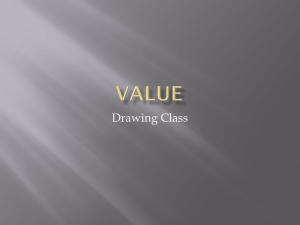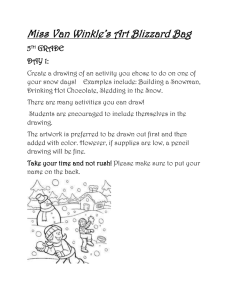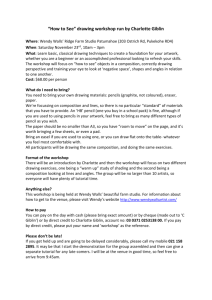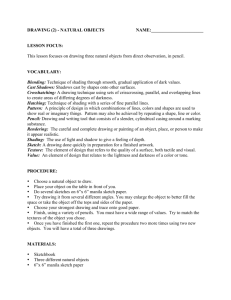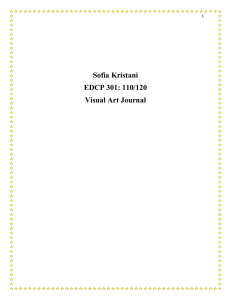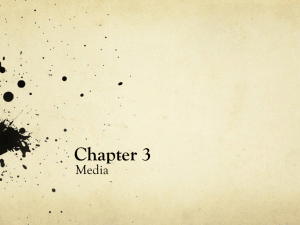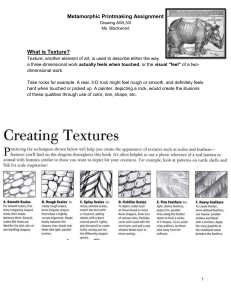File
advertisement
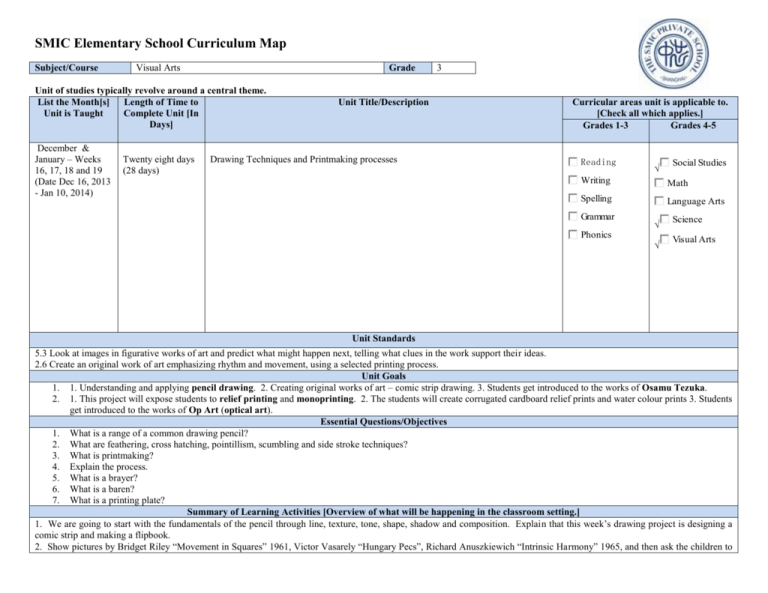
SMIC Elementary School Curriculum Map Subject/Course Visual Arts Grade Unit of studies typically revolve around a central theme. List the Month[s] Length of Time to Unit is Taught Complete Unit [In Days] December & January – Weeks 16, 17, 18 and 19 (Date Dec 16, 2013 - Jan 10, 2014) Twenty eight days (28 days) Unit Title/Description Drawing Techniques and Printmaking processes 3 Curricular areas unit is applicable to. [Check all which applies.] Grades 1-3 Grades 4-5 Reading √ Social Studies Writing Math Spelling Language Arts Grammar Phonics √ Science √ Visual Arts Unit Standards 5.3 Look at images in figurative works of art and predict what might happen next, telling what clues in the work support their ideas. 2.6 Create an original work of art emphasizing rhythm and movement, using a selected printing process. Unit Goals 1. 1. Understanding and applying pencil drawing. 2. Creating original works of art – comic strip drawing. 3. Students get introduced to the works of Osamu Tezuka. 2. 1. This project will expose students to relief printing and monoprinting. 2. The students will create corrugated cardboard relief prints and water colour prints 3. Students get introduced to the works of Op Art (optical art). Essential Questions/Objectives 1. What is a range of a common drawing pencil? 2. What are feathering, cross hatching, pointillism, scumbling and side stroke techniques? 3. What is printmaking? 4. Explain the process. 5. What is a brayer? 6. What is a baren? 7. What is a printing plate? Summary of Learning Activities [Overview of what will be happening in the classroom setting.] 1. We are going to start with the fundamentals of the pencil through line, texture, tone, shape, shadow and composition. Explain that this week’s drawing project is designing a comic strip and making a flipbook. 2. Show pictures by Bridget Riley “Movement in Squares” 1961, Victor Vasarely “Hungary Pecs”, Richard Anuszkiewich “Intrinsic Harmony” 1965, and then ask the children to describe each one of them (one at a time). Explain to them that all of the works that they saw are called “prints”. Let them know that they will try relief printing and monoprinting themselves and that by the end of the lesson they should’ve made at least two prints. Assessment—What is used to determine student’s level of Resources Used/Needed—include textbooks, software, hardware, Key/Essential Vocabulary Words knowledge and skills. websites, manuals, equipment, etc. Used in Unit 1. The student recognizes the importance of grid drawing and Water colours/ brushes/ sketchbook/ pencils/ erasers/ computer/ ppt/ Drawing/ pencils/ printmaking/ print is able to complete a drawing using a variety of drawing projector/ paper/brayer/plexiglass plates/ baren/ template ‘Exploring pencils. qualities and Properties of various Grades of Drawing Pencils’ 2. The student identifies the differences between drawing pencils and chooses the ones that are most appropriate for his/her original works of art. 3. The student is able to independently pull a print and to explain the printmaking process. SMIC Middle/High School Expected School Wide Learning Results. Check all which applies. Global Citizens. Students will engage in positive active citizenship through respect for the environment, commitment to charitable causes, and an appreciation for cultural diversity. Persons of Character. Students will consistently choose to respect self and others. Motivated Learners. Students will demonstrate a passion for learning and an intellectual curiosity through creativity, initiative, collaboration, and problem solving. Healthy Individuals. Students will make appropriate choices that reflect physical well-being as well as social and emotional maturity. Teacher Reflection. Upon completion of unit, include questions which can be addressed include: Were the students engaged throughout the unit? How do I know that the objectives were met and students learned what was intended? Were my lessons effective? How can I improve this unit in the future to better benefit my students? What can I do differently? What activities worked well and should be used the next time that this unit is taught? What activities did not work too well and need to be redesigned before the next time that this unit is taught? If you could change anything in this unit, what would you change? What additional support facilities could have been used to improve this unit?





